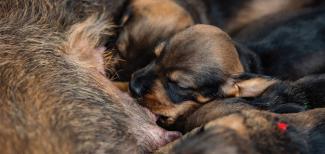Dr. Hesser: Ovulating timing, breeding to quality semen from a proven stud dog, and monitoring the pregnancy properly are key to success. It sounds like you are on track and doing things correctly. Bitches can have a multitude of primary conditions, ranging from inflammatory to cystic- to cyclic-associated diseases. Consulting with a specialist may reveal a very clear primary abnormality.
High inbreeding coefficients have been shown to have great impact on litter size, so ensuring you have genetic variability may help you depending on the options available. I also find it amazing the positive impact that comes from practicing good basic pregnancy management, feeding a healthy diet and monitoring body condition, allowing moderate exercise throughout pregnancy, and adhering to deworming regimens. After all these things have been considered, we look at uterine testing to determine the cause of pregnancy problems. I suggest waiting for two well-bred cycles that “miss” before reaching out for an intensive workup, as this takes some effort and expense.
If a bitch misses repeatedly, we usually advise having a uterine biopsy at around the time she would have her puppies, as the cervix becomes open. I perform this procedure with sedation using an endoscope to take a tiny biopsy of the endometrium. If a bitch is having a C-section, I sometimes take a biopsy during the surgery. Biopsy samples are sent for laboratory analysis to assess her future fertility. The most common reports we receive back are normal and inflammatory or cystic conditions. Dogs rarely have fibrosis, or scar tissue. Occasionally a fungal or other rare pathogen is observed on biopsy.
For most bitches, we perform a uterine culture at the onset of estrus (heat), even if some problem is identified on biopsy. When a breeder is investing in a cycle, it is best to have the full picture and optimize everything possible. I collect cultures of the uterus using a transcervical scope with the patient awake as well as cytology (cellular fluid) samples, which are sent for laboratory testing. Ideally, the results are returned in time to treat any underlying bacterium species. Keep in mind that sometimes after great financial input, everything is normal and there is nothing to fix.

